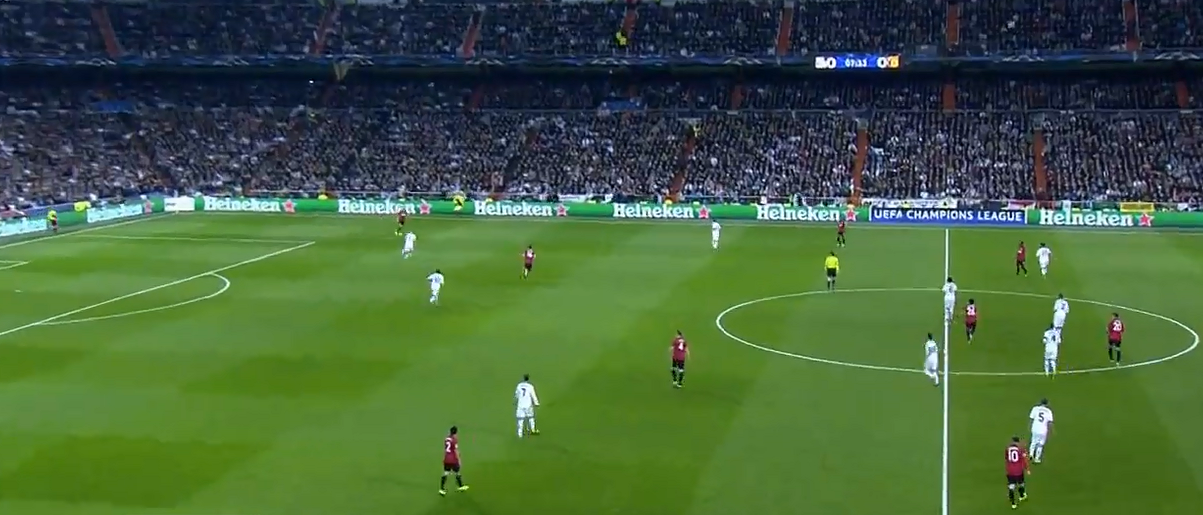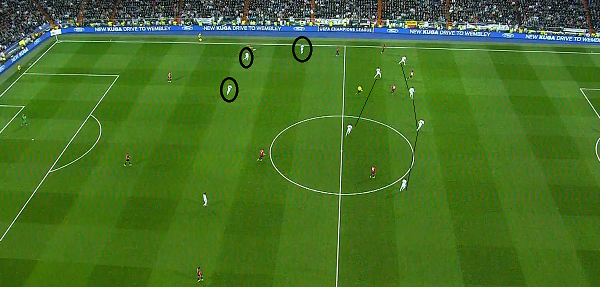Dubbed ‘the perfect match’ it truly did provide glimpses of its hype, but certainly not ‘the perfect match’. Manchester United will be the happier of the 2 sides, with Real Madrid needing to do the dirty work at Old Trafford in order to progress to the quarter-finals. In fact, Manchester United put in an inspiring defensive display, and sometimes offensive play. David De Gea was no doubt the stand out performer for the Red Devils, deny numerous Los Blancos’ chances. Danny Welbeck look threatening all game until he was substituted out. It all comes down to clinical nature – and in this case, Real Madrid were not.
Line-ups

Real Madrid v Manchester United line-ups [this11.com]
Madrid’s Early Pressure
Madrid’s game plan came apparent very early on. They looked to pen back Manchester United, applying high pressure whenever the defence was in possession and allowed them minimal time to decide on their next action.

Pressure of Real Madrid – Minute 7′.
In possession, just after United’s goal kick, as soon as Rio Ferdinand receives the ball, Karim Benzema is already on his toes. Mesut Ozil is ready to come over to apply pressure to Michael Carrick if he was to receive it. That back four are a matter of yards from the halfway line, so it indicate they’re playing a high line and sort of teasing Manchester United’s forward 4 to make runs in behind. It also indicates that Real Madrid want them to play the ball over the top in behind them, instead of allowing them to use Carrick who this year has been in fine form.

Aerial view of Real Madrid’s pressure.
From the image above, Evra is just about to play the ball over the top of Real Madrid’s back four – just what Los Blancos wanted them to do so. Circled in black, Karim Benzema, Mesut Ozil and Angel Di Maria, are all within 10 yards of Evra so it gives no option for Evra but to play it long, but because of the pace of Real Madrid’s centre halves, it doesn’t cause the same problems it would for other teams. Varane and Ramos looked comfortable throughout if they had to chase a long ball aimed for the runs of van Persie, Welbeck, Kagawa or Rooney.
Content to Sit Back and Defend
Whilst Real Madrid pressed high, it meant it pushed Manchester United back and not allowing them the freedom to play up the pitch, though, they were fairly content to do this in order to concede as little goals as possible if not none.

All Manchester United players within 35 yards of their own goal.
The image above is a prime example of the use of the so-called ‘park the bus’ tactic used. It worked well, and only allowed Real Madrid to score one goal, which happened after Manchester United’s goal, and after the goal United’s defending slightly deteriorated. At times, United’s defending resilience looked like a change in formation with one appearing more than others.

A distinct ‘5-3-2’ formation when United were defending.
From the image above in the 66th minute, the beginnings of a 5-3-2 appeared. Rooney dropped back into a right wing-back position whilst Rafael shifted centrally and acted as the 3rd centre-half. This proved a huge stumbling block for Real Madrid’s advances as there were very limited gaps (although in this image above, there is a relatively big gap between Evra and Evans) that Madrid could play through.

Similar defensive formations appear moments later.
The compact defending didn’t allow Real Madrid to play the way they wanted to, but attacking areas at the pace of Di Maria, Benzema and Ronaldo, which effectively proved vital in the final result. Below is a better view of my point suggesting that some sort of 5-3-2 was deployed in the 2nd half to stop Real Madrid from scoring.

An image late on of the 5-3-2 formation.
Resolute Defending Works
Due to Manchester United’s resolute and brilliant defensive display, added to the fact that they got a substantial amount of players behind the ball in a quick fashion, it limit Real Madrid’s chances hugely. Their attempts were very much taken from distance, due to the small amount of gaps which were playable through.

Real Madrid’s shot zone percentage. [whoscored.com]
Introduction of Valencia
Antonio Valencia was introduced in the 75th minute as a substitute for Danny Welbeck, and offered a new dimension to Manchester United, which could’ve seen them actually taken away a win had the Red Devils used his effectiveness to full potential. Instantly, coming on as a sub, Valencia made an impact and was playing very wide and giving Manchester United options which they hadn’t had in both Welbeck and Rooney, who naturally, drifted in centrally so an option out wide wasn’t apparent.

Circled in red, Valencia gave Manchester United width.
I’ve highlighted Valencia in red, who is ‘hugging’ the touchline. As soon as Jones (in possession) is about to pass it Coentrao, left-back for Madrid, is on his way to close down Valencia leaving a big gap between himself and Ramos, which can easily be exposed by van Persie or Anderson. Fast forward the scenario.

The gap between Ramos and Coentrao has become larger.
Resume the situation and Valencia has just received the pass from Jones. The gap created by Valencia’s width is now being exposed to the maximum, with Rafael rushing to exploit it. Coentrao has decided to back track and follow Rafael’s run so the move comes to nothing, but had Jones’ initial pass to Valencia been of better quality, a 2-on-1 situation was on for Manchester United between Valencia and Rafael vs Coentrao. Had Valencia and/or Rafael gone past Coentrao, a 3v3 situation takes place in the box, which may have seen Manchester United capitalize on the situation and potentially score a late winner.

Another image of the effect Valencia had using width.
The introduction of Valencia stretched Real Madrid, and had someone like Shinji Kagawa who looks to get in behind the opponents defence in prediction of a knock-on, Manchester United may have used Valencia’s effectiveness to a big advantage.
Conclusion
A solid defensive display by Sir Alex’s side had the major influence on the full-time result. Real Madrid struggling to play their usually game, getting beyond opponent defensive line. Jose Mourinho was frustrated throughout the game by United’s tactics, so we’ll say that Sir Alex won the tactics department. Mourinho told an interviewer just what he thought – “They changed their style of play, Rio Ferdinand and Jonny Evans didn’t step foot in our half. But they did well, defended well.” In fairness, Real Madrid maybe deserved the advantage going into the 2nd leg at Old Trafford but an inspired performance by David De Gea denied them that advantage. All to play for at Old Trafford, and the tie could very well go to either side.


























































